
Start a Successful Online Grocery Store: How-to Guide
Looking to tap into the booming online market?
Interested in setting up a business that caters to the everyday needs of people?
How about starting a successful online grocery store? Intrigued by the idea but unsure where to begin?
You’re not alone.
The prospect of starting an online grocery store can seem daunting, but with the right guidance and tools, it’s a journey that can lead to significant profits and a rewarding business experience.
In this comprehensive how-to guide, we’ll walk you through the essentials of starting your online grocery store.
From choosing the right ecommerce platform to understanding your target market, from managing your inventory to setting up a seamless delivery system, we’ve got you covered.
Ready to embark on this exciting journey?
Let’s dive in and explore the world of online grocery business.
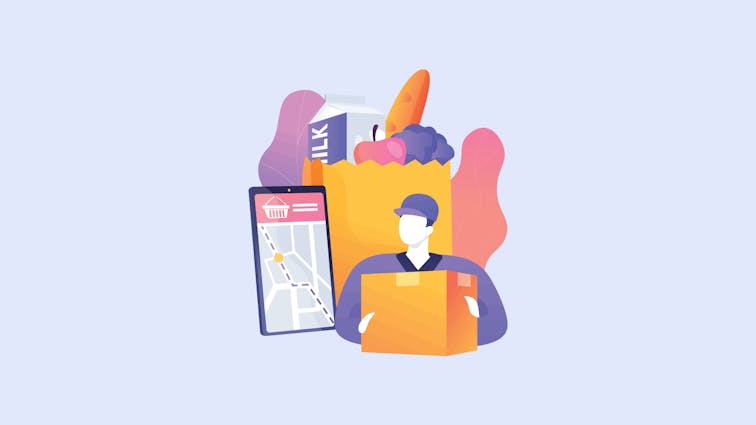
In recent years, the popularity of online grocery stores has skyrocketed. This trend can be attributed to several factors, including the convenience and accessibility that online shopping provides.
Consumers can browse and purchase items from the comfort of their own homes, without having to physically visit a brick-and-mortar store.
Additionally, online grocery stores often offer a wider range of products and brands than traditional supermarkets, making it easier for consumers to find what they need.
The COVID-19 pandemic has also played a significant role in the surge in demand for online grocery shopping.
As social distancing measures became necessary, many consumers turned to online retailers to avoid crowded stores and reduce their risk of exposure.
This shift in consumer behavior has led to an unprecedented level of growth in the online grocery industry.
Here are some essential figures that you should be aware of:
-
The online grocery market in the US is projected to reach $250 billion by 2025.
-
Since the onset of the pandemic, there has been a 30% global increase in the number of customers opting for online grocery shopping.
-
The global grocery market is expected to generate $1.9 trillion in revenue by 2023.
-
The total number of downloads for online grocery mobile apps has surpassed 200%.
What is an online grocery store?
An online grocery store is a business that sells groceries and other food items through a website or mobile app. Online grocery stores offer a convenient and time-saving alternative to traditional brick-and-mortar grocery stores. Customers can browse and purchase groceries from the comfort of their own homes, and have them delivered to their door.
Some of the benefits of using an online grocery store include:
- Convenience: Online grocery shopping is a convenient way to buy groceries. Customers can shop at any time of day or night, and they don’t have to worry about fighting traffic or finding a parking spot.
- Time savings: Online grocery shopping can save customers time. They don’t have to spend time driving to and from the grocery store, or waiting in line to check out.
- Flexibility: Online grocery shopping offers customers flexibility. They can choose to have their groceries delivered to their door, or they can pick them up at a designated location.
Here are some examples of popular online grocery stores:
- Amazon Fresh: Amazon Fresh is a grocery delivery service that offers a wide variety of fresh produce, meat, seafood, dairy, baked goods, snacks, and more. Amazon Fresh also offers a variety of prepared foods, such as pizzas, salads, and sandwiches.
- Instacart: Instacart is a grocery delivery service that partners with local grocery stores to deliver groceries to customers’ homes. Instacart offers a wide variety of grocery items, including fresh produce, meat, seafood, dairy, baked goods, snacks, and more.
- Walmart Grocery: Walmart Grocery is a grocery delivery service that offers a wide variety of grocery items, including fresh produce, meat, seafood, dairy, baked goods, snacks, and more. Walmart Grocery also offers a variety of prepared foods, such as pizzas, salads, and sandwiches.
Read More: Advantages & Disadvantages of Online Grocery Stores: Convenience and Cost-effectiveness
Overview: Steps on How To Start An Online Grocery Store

Starting an online grocery store requires careful planning and research into the market, competition, and target audience.
Broadly speaking, the steps below outline the process you need to follow.
- Do your research & Business plan
- Choose a business model
- Set up your website or mobile app
- Source your products
- Set up your fulfillment process
- Market your online grocery store
- Provide excellent customer service
Starting an online grocery store is a big undertaking, but it can be a very rewarding business. By following these steps, you can increase your chances of success.
Here are some additional tips for starting an online grocery store:
- Offer a wide variety of products. The more products you offer, the more likely you are to attract customers.
- Keep your prices competitive. Customers are always looking for the best deals, so it’s important to keep your prices competitive.
- Offer free shipping or discounted shipping. Free shipping or discounted shipping is a great way to attract customers and encourage them to shop with you.
- Offer a loyalty program. A loyalty program is a great way to reward your customers for their business. You can offer discounts, free products, or other perks to members of your loyalty program.
- Make it easy to shop. Your website or mobile app should be easy to use and navigate. Customers should be able to find the products they’re looking for quickly and easily.
1. Do your research & Business plan
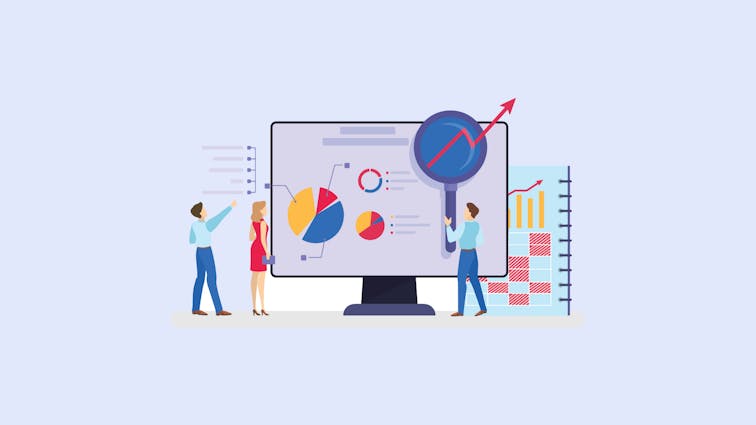
Before you start your online grocery store, it’s important to do your research and understand the market. This includes understanding the competition, the target market, and the logistics of running an online grocery store.
A. Understand the competition
There are a number of online grocery stores already operating, so it’s important to understand what they’re doing well and where they’re falling short.
You can do this by visiting their websites, reading reviews, and talking to customers.
B. Identify your target market
Who are you trying to sell to? What are their needs and wants? Once you know who your target market is, you can tailor your products, prices, and marketing to appeal to them.
C. Understand the logistics of running an online grocery store.
There are a number of logistical challenges involved in running an online grocery store, such as:
- Warehousing and inventory management
- Delivery
- Customer service
- Payment processing
- Marketing
It’s important to understand these challenges and develop a plan for how you will overcome them.
Here are some additional tips for doing your research:
- Talk to experts. Talk to people who are already in the online grocery business. They can give you valuable insights and advice.
- Read industry publications. There are a number of industry publications that can keep you up-to-date on the latest trends and developments in the online grocery industry.
- Attend industry events. Attending industry events is a great way to network with other online grocery retailers and learn about the latest trends and technologies.
By doing your research, you can increase your chances of success in the competitive online grocery market.
D. Developing a business plan
A business plan is a detailed document outlining how you intend to run your online grocery store.
It should include key information such as vision statements, mission statements, organizational structure among others.
The plan should also detail how much capital will be required to start up the business as well as projections for future growth.
In addition to this financial aspect of the plan should include creating a budget and deciding on pricing strategies which are covered below
E. Creating a budget
Creating a budget is an essential part of developing a business plan since all costs associated with starting up must be accounted for before launching an online grocery store.
The budgets should outline anticipated expenses such as website development costs, marketing expenses, inventory purchases, salaries and wages for any employees as well as other general overhead costs.
F. Deciding on pricing strategy
Pricing strategy is an essential part of developing a business plan since it determines the profitability of your online grocery store.
You need to decide if you want to compete with other stores in terms of pricing or differentiating your offerings by offering higher quality products.
Some strategies include offering low prices and larger product selections or niche market targeting where the focus is on high-quality products.
You should choose the most suitable pricing strategy based on your target audience and competition in the area.
Conducting market research, analyzing your competition and developing a detailed business plan with a budget and pricing strategies will help you set up an online grocery store that meets customer needs while remaining profitable.
It’s essential to remember that these steps are not one-time events but require frequent evaluation so that you can pivot when necessary to remain competitive.
2. Choose a business model
There are two main business models for online grocery stores: the direct-to-consumer model and the marketplace model.
The direct-to-consumer model means that you own and operate your own warehouses and delivery fleet.
The marketplace model means that you partner with local grocery stores to deliver groceries to customers’ homes.
- Direct-to-consumer model: In this model, the online grocery store owns and operates its own warehouses and delivery fleet. This model gives the online grocery store more control over the customer experience, but it also requires a significant investment in infrastructure and operations.
- Marketplace model: In this model, the online grocery store partners with local grocery stores to deliver groceries to customers’ homes. This model is less capital-intensive than the direct-to-consumer model, but it also gives the online grocery store less control over the customer experience.
Read more: 5 Types of Ecommerce Business Models That Works
3. Set up your website or mobile app
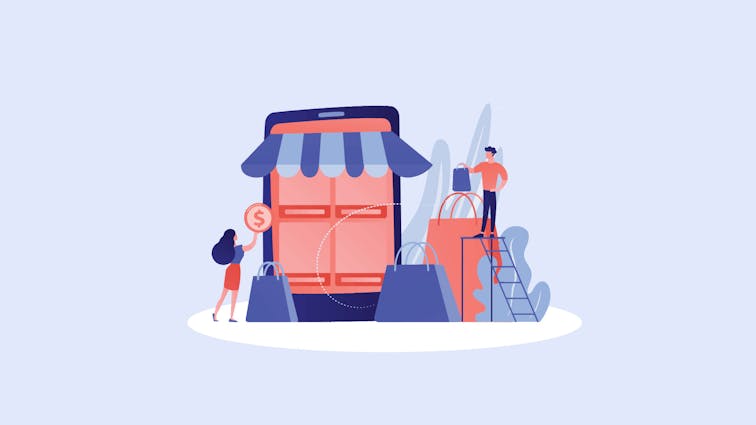
A. Choosing a domain name and hosting service
Choosing the right domain name is crucial for your online grocery store. It should be short, memorable, and easy to spell. Ideally, it should also include a relevant keyword that is related to your business.
You can use tools like GoDaddy or Namecheap to find available domain names. Once you have chosen your domain name, you will need to select a hosting service.
A good hosting service ensures that your website is accessible and loads quickly for customers.
Some popular hosting services for ecommerce websites are Bluehost, SiteGround, and HostGator.
B. Selecting an ecommerce platform (Aasaan)
Selecting the right ecommerce platform depends on your budget and specific business needs. Aasaan, Shopify, WooCommerce, and Magento are popular options.
Aasaan is an all-in-one solution that offers pre-built templates, web hosting and payment gateways.
It’s user-friendly interface makes it easy for beginners to launch an online store quickly. WooCommerce is a plugin built specifically for WordPress websites which offers flexibility in design and customization options while also allowing integration with other plugins such as search engine optimization (SEO) plugins.
Magento is a more advanced platform suited for larger businesses with multiple stores or channels. It allows more customization than other platforms but requires some knowledge of coding.
C. Comparing different platforms (Shopify, WooCommerce, Magento)
Each ecommerce platform has its own set of pros and cons depending on what you need from it.
Aasaan provides ease of use while, WooCommerce offers greater flexibility in terms of design options through integration with WordPress themes whereas Magento gives you complete control over design elements through custom coding abilities but at the cost of development time .
Consider factors such as cost ,features offered, support provided, customer reviews, business scalability before choosing one among these platforms
D. Customizing your website design and layout
Customizing your website design and layout is important for creating a user-friendly experience. Platforms like Aasaan, Shopify and WooCommerce offer pre-built themes that can be customized to fit your brand.
However, if you are looking for a unique design, you can hire a designer or developer to build a custom theme.
Consider the overall aesthetics of your brand when designing your website. Use high-quality images, consistent color schemes throughout, and clear fonts to convey professionalism.
Ensure that your website is mobile-friendly as most customers will be accessing it through their phones, making it easier to navigate and shop on the go.
In addition to this ensure that checkout process is quick and easy without too many distractions as it encourages conversion rate.
Building an online store requires careful planning in selecting the right domain name ,hosting service ,ecommerce platform and customization of website design that enhances customer experience .
Choose an ecommerce platform based on its features offered, cost, support provided, customer reviews, business scalability among other factors as they play crucial role in determining the success of online grocery store.
RELATED: Best Online Grocery Ecommerce Platforms to Build Your Grocery Website
3. Sourcing Products
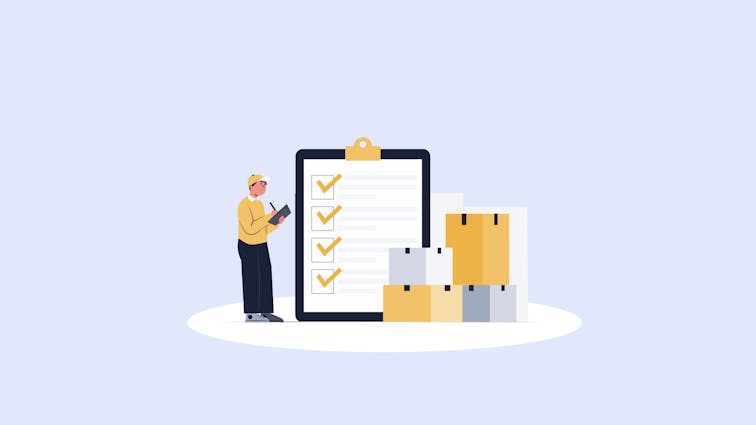
Source your products. You’ll need to source your products from a variety of suppliers.
This includes finding suppliers who can provide you with the products you need at a competitive price.
- Identify your suppliers: The first step is to identify potential suppliers. You can do this by searching online, attending trade shows, or networking with other business owners.
- Compare prices and quality: Once you have identified a few potential suppliers, you need to compare their prices and quality. You should also consider factors such as shipping costs, lead times, and customer service.
- Negotiate prices: Once you have chosen a supplier, you need to negotiate prices. You should be prepared to haggle and walk away if you are not happy with the price.
- Set up a contract: Once you have agreed on a price, you need to set up a contract. This will protect you and your supplier in case of any problems.
Here are some additional tips for sourcing products:
- Build relationships with suppliers: It is important to build relationships with your suppliers. This will help you to get better prices, faster shipping, and better customer service.
- Be prepared to negotiate: As mentioned earlier, you should be prepared to negotiate prices with your suppliers. This is especially important if you are buying in bulk.
- Be aware of the risks: There are risks associated with sourcing products from overseas suppliers. These risks include quality control issues, shipping delays, and language barriers.
By following these tips, you can source high-quality products at competitive prices. This will help you to attract customers and grow your business.
Here are some of the most popular ways to source products for your online grocery store:
- Wholesale distributors: Wholesale distributors are businesses that buy products in bulk from manufacturers and then sell them to retailers. They are a good source for a wide variety of products at competitive prices.
- Manufacturers: If you are looking for unique or specialty products, you may want to consider sourcing them directly from the manufacturer. This can be a more expensive option, but it can also give you more control over the quality and pricing of the products.
- Online marketplaces: Online marketplaces like Amazon and eBay allow you to buy products from a variety of sellers. This can be a good option if you are looking for specific products or if you want to compare prices from different sellers.
- Trade shows: Trade shows are a great way to meet with potential suppliers and learn about new products. They can be a good source for finding unique or hard-to-find products.
No matter which method you choose, it is important to do your research and compare prices from different suppliers.
This will help you to find the best deals on the products you need.
4. Set up your fulfillment process
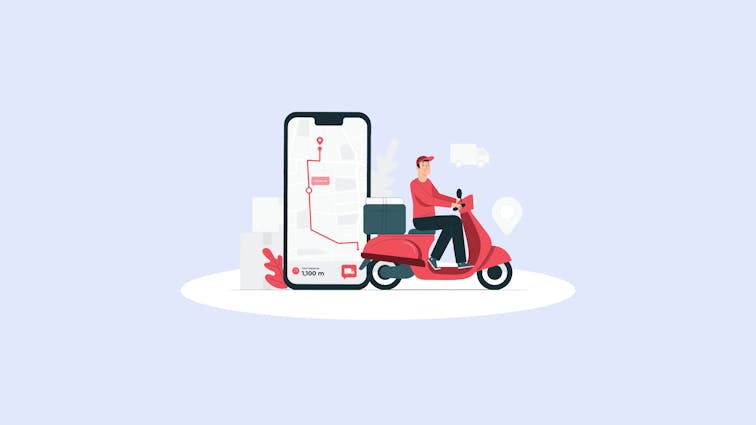
The fulfillment process is the process of getting your products from your suppliers to your customers. This includes picking, packing, and shipping the products.
A. Choose a fulfillment method:
There are two main types of fulfillment methods: in-house fulfillment and third-party fulfillment.
In-house fulfillment means that you will handle all aspects of the fulfillment process, including receiving inventory, picking and packing orders, and shipping them to customers.
Third-party fulfillment means that you will outsource the fulfillment process to a company that specializes in this area.
B. Set up your warehouse:
If you choose to do in-house fulfillment, you will need to set up a warehouse to store your inventory. The size and layout of your warehouse will depend on the size of your business and the volume of orders you expect to receive.
C. Choose a shipping method:
There are many different shipping methods available, including ground shipping, express shipping, and expedited shipping. The shipping method you choose will depend on the needs of your customers and the type of products you sell.
D. Set up your shipping software:
You will need to use shipping software to track orders, print shipping labels, and generate shipping invoices. There are many different shipping software programs available, so you should choose one that meets the needs of your business.
E. Train your staff:
If you have employees who will be involved in the fulfillment process, you will need to train them on how to properly pick, pack, and ship orders.
Once you have set up your fulfillment process, you will need to monitor it on a regular basis to ensure that it is running smoothly.
You should track order fulfillment metrics such as order accuracy, shipping times, and customer satisfaction levels.
By monitoring your fulfillment process, you can identify areas where improvements can be made.
Here are some additional tips for setting up a successful fulfillment process:
- Choose a fulfillment method that is right for your business. If you have a small business with low volume of orders, in-house fulfillment may be a good option for you. However, if you have a large business with high volume of orders, third-party fulfillment may be a better option.
- Set up your warehouse in a strategic location. The location of your warehouse will affect shipping times and costs. You should choose a location that is close to your target market and that has access to major transportation hubs.
- Choose a shipping method that meets the needs of your customers. Not all customers are created equal. Some customers may be willing to wait longer for their orders, while others may need their orders to arrive quickly. You should offer a variety of shipping methods to meet the needs of all of your customers.
- Invest in shipping software. Shipping software can help you track orders, print shipping labels, and generate shipping invoices. This can save you time and money.
- Train your staff on how to properly pick, pack, and ship orders. This is essential for ensuring that orders are processed correctly and that customers are satisfied with their experience.
- Monitor your fulfillment process on a regular basis. This will help you identify areas where improvements can be made.
5. Market your online grocery store
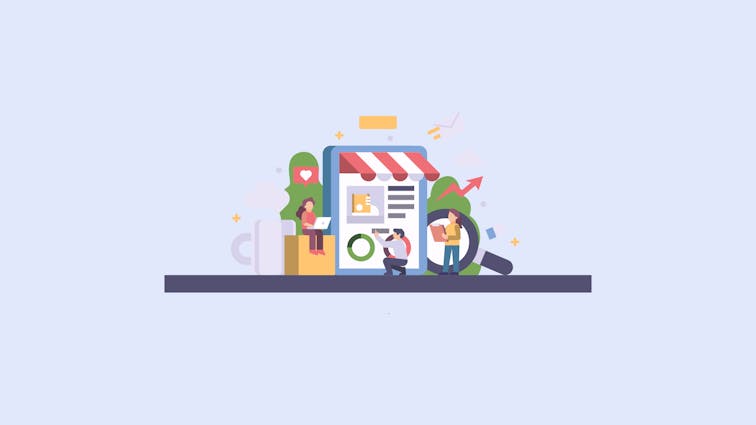
Having an online grocery store is one thing, but making sure that customers are aware of your store’s existence is another.
Marketing your online grocery store will help you reach new customers and keep existing ones coming back for more.
A well-executed marketing plan can generate traffic to your website, increase brand awareness, and ultimately boost sales.
Once your online grocery store is up and running, you’ll need to market it to potential customers. This includes using online marketing channels such as search engine optimization (SEO), pay-per-click (PPC) advertising, and social media marketing.
A. SEO:
Search engine optimization (SEO) is the process of improving the ranking of your website in search engine results pages (SERPs).
When done correctly, SEO can help you attract more organic traffic to your website, which can lead to more sales.
There are many things you can do to improve your website’s SEO, such as creating high-quality content, optimizing your website’s titles and meta descriptions, and building backlinks to your website.
B. PPC:
Pay-per-click (PPC) advertising is a type of online advertising where you pay each time someone clicks on your ad.
PPC ads can be displayed on search engines, social media platforms, and other websites.
When creating PPC ads, it’s important to choose the right keywords and set a budget that you’re comfortable with.
C. Social media marketing:
Social media marketing is a great way to connect with potential customers and promote your online grocery store.
You can use social media platforms like Facebook, Twitter, and Instagram to share news about your store, promote special offers, and engage with customers.
D. Email marketing:
Email marketing is a great way to stay in touch with your customers and promote your online grocery store.
You can use email marketing to send out newsletters, promotional offers, and other messages to your subscribers.
E. Referral marketing:
Referral marketing is a great way to get new customers. You can offer incentives to your existing customers for referring their friends and family to your store.
It’s important to use a variety of marketing channels to reach your target audience.
By using a combination of SEO, PPC, social media marketing, email marketing, and referral marketing, you can reach more potential customers and grow your online grocery store.
Here are some additional tips for marketing your online grocery store:
- Create a strong brand: Your brand is what will set you apart from your competitors. Make sure your brand is consistent across all of your marketing channels.
- Offer great customer service: Excellent customer service is essential for any business, but it’s especially important for online businesses. Make sure you’re responsive to customer inquiries and that you resolve any issues promptly.
- Keep up with the trends: The online grocery market is constantly evolving. Make sure you’re aware of the latest trends and that you’re adapting your marketing strategy accordingly.
- Measure your results: It’s important to track the results of your marketing campaigns so that you can see what’s working and what’s not. This will help you make adjustments to your strategy and improve your results over time.
6. Provide excellent customer service

Providing excellent customer service is essential for any online business.
This includes responding to customer inquiries promptly, resolving customer issues quickly, and providing a positive shopping experience.
A. Be responsive:
Customers expect to be able to get in touch with you quickly and easily.
Make sure you have multiple ways for customers to contact you, such as phone, email, and live chat.
And make sure you respond to customer inquiries within 24 hours, if not sooner.
B. Be helpful:
When a customer contacts you with a problem, your goal should be to help them resolve it as quickly and easily as possible.
Be patient, listen to their concerns, and offer solutions that are tailored to their individual needs.
C. Be friendly and professional:
Even if you’re dealing with a difficult customer, it’s important to remain friendly and professional.
Remember that the way you interact with customers can make a big difference in their overall experience with your company.
D. Be proactive:
Don’t wait for customers to come to you with problems. Be proactive and reach out to customers to see how they’re doing and if there’s anything you can do to help them.
This shows that you care about their experience and that you’re committed to providing excellent customer service.
E. Go the extra mile:
Sometimes, the best way to provide excellent customer service is to go the extra mile.
This could mean offering a refund or replacement for a product that didn’t meet the customer’s expectations, or it could mean giving them a free gift as a thank-you for their business.
Going the extra mile shows customers that you appreciate their business and that you’re willing to do whatever it takes to make them happy.
By following these tips, you can provide excellent customer service that will help you build loyalty and keep customers coming back for more.
Here are some additional tips for providing excellent customer service:
- Be knowledgeable about your products or services. This will help you answer customer questions quickly and accurately.
- Be empathetic. Put yourself in the customer’s shoes and try to understand their situation.
- Be solution-oriented. Focus on finding solutions to customer problems, rather than just apologizing for the problems.
- Be positive. A positive attitude can go a long way in creating a positive customer experience.
- Be consistent. Provide the same level of customer service to all customers, regardless of the size of their purchase or the issue they’re experiencing.
By following these tips, you can provide excellent customer service that will help you grow your business.
Conclusion
Starting an online grocery store may seem daunting at first, but with careful planning and attention to detail it can be a highly rewarding undertaking.
By identifying your target market and developing a business plan that includes budgeting, pricing strategy, sourcing products from suppliers etc., you can lay the groundwork for success.
Choosing the right ecommerce platform and building an attractive website will help set you apart from competitors who may not give as much attention to their online storefronts.
And by providing excellent customer service throughout the shopping process - from delivery tracking information to responsive communication - you’ll build trust with your audience.
Although there are challenges involved in launching any new business venture - especially one as complex as an online grocery store - there are also many rewards: becoming part of a growing industry, providing a valuable service to customers who may not have easy access to fresh, healthy food, and building a loyal customer base that will help you sustain and grow your business over time.
So if you’re passionate about food and entrepreneurship, consider taking the leap and starting your own online grocery store today.
FAQ’s:
1. How can I succeed in the online grocery business?
To succeed in the online grocery business, focus on providing a seamless shopping experience, offering a wide variety of products, competitive pricing, and excellent customer service. Also, ensure efficient delivery and inventory management systems are in place.
2. Is the online grocery business profitable?
Yes, the online grocery business can be profitable, especially with the increasing consumer preference for online shopping. However, profitability depends on factors like efficient operations, effective marketing, and customer retention strategies.
3. How can I improve my online grocery shopping experience?
Improving the online grocery shopping experience can be achieved by ensuring a user-friendly website, offering personalized recommendations, providing various payment options, and ensuring timely and reliable delivery services.
4. What factors would you consider while setting up an online grocery store?
When setting up an online grocery store, consider factors like the target market, product selection, pricing strategy, delivery logistics, website design, and customer service.
5. What are 3 disadvantages of grocery shopping online?
Three disadvantages of grocery shopping online include: inability to physically inspect products before purchase, potential for delivery delays, and sometimes higher prices due to delivery charges.








